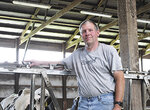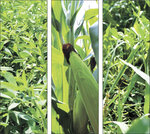Michael Kolb
Paynesville, Minnesota
450 cows
Describe your farm and facilities. We are a family run crop and dairy farm. We milk 450 cows in a parlor and house them in a freestall barn that is bedded with recycled manure solids.
What forages do you harvest? We harvest haylage, corn silage and oatlage.
How many acres of crops do you raise? We farm 300 acres of oat, 300 acres of alfalfa, 1,100 acres of corn and 350 acres of soybean.
Describe the rations for your livestock. I run a lactating cow diet that consists of fine ground dry corn, high moisture corn, fine ground oat, liquid molasses, protein mineral mix, haylage and corn silage. My goal for my lactating cow diet is to make all components of the feed highly digestible for the cows. This has helped me reach a rolling herd average of 30,000 pounds, a 95-pound tank average with 4% fat and 3.3% protein. By the time their bodies process the ration, they have utilized a majority of the nutrients in the diet. My heifer and dry cow diets consist of different rations using corn silage, soybean meal, mineral supplements, oatlage and grass hay. We have a bit of meadow lands that we harvest the grass from and use in the diets in place of using wheat straw which is pretty common in transition diets. It’s a way to use all available resources on our operation. Our heifers have been freshening well and transitioning into peak production, some averaging 33,00 pounds in their first year.
What quality and quantity do you harvest of each crop? We harvest around 2,500 tons of haylage each year. The quality we generally put up is 55%-60% moisture, 22%-24% protein, relative feed value of 165 and relative forage quality of 180. We have about 7,000 tons of corn silage. The moisture is 65%-68%, 40% starch and a corn processing score of less than 80%.
Describe your harvesting techniques for alfalfa and corn silage. We use Shredlage technology in our Claas chopper to help with processing. It does a great job of cutting up forages into bite-size pieces for the cows. We regularly sharpen blades on our chopper to ensure we are getting a clean cut while processing. I also set my kernel processor to a minimal gap to process the corn.
What techniques do you use to store, manage and feed your forages? We grow our alfalfa on a four-year rotation, and we interseed grass to replace tonnage as the stands thin. I believe the grass makes it more digestible for the cows. We try to cut just before the alfalfa blooms. For corn silage, we plant conventional corn and harvest at around 65% moisture. We use bunkers to store corn silage and haylage for the milking cows. The bunkers are double covered with plastic, and also have plastic down the walls. We get very little spoilage. I drive the packing tractor and everyone calls me the bunker police because I monitor forage processing and packing. We store oatlage and corn silage in packed and covered piles for the heifers and dry cows.
How do quality forages play into the production goals of your herd? When we placed more emphasis on the quality of our forages, our cows responded well. By processing the forages better the cows are able to utilize the feed better. As the forages move through the rumen, they are supposed to feed the bacteria in the rumen. We stopped focusing on making “jet fuel” haylage and adjusted the diets in other ways. Our cows have increased production, and there is less wasted feed going out the back end of my cows. This is what works for our herd, and I’m thoroughly pleased with the results.
What management or harvesting techniques have you changed that have made a notable difference in forage quality? Other than sharpening and adjusting equipment regularly, employee management has been big. The hardest part about making quality forages is finding a way to help people understand how their actions affect the quality. Once we found a way to communicate the importance of the way we do forage harvesting and why we do things a certain way, our stored feed quality improved a ton.
Describe a challenge you overcame in reaching your forage quality goals. Last year, our chopper blew its turbo while starting corn silage. We got that fixed, then our hydrostatic drive went out. We had to wait two weeks to get the part. We ended up using a rented chopper and had to continue adjusting some of the parts to get the right cutting length. You can see the difference in the pile from where we started to where we ended. The particle length with the rented chopper was longer than I would like, but we turned it around quickly. The rest of the pile looks good. This just goes to show how important it is to get your equipment adjusted right.


Comments
No comments on this item Please log in to comment by clicking here